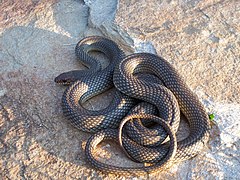Coluber caspius
| Caspian whipsnake | |
|---|---|
 |
|
| Scientific classification | |
| Kingdom: | Animalia |
| Phylum: | Chordata |
| Class: | Reptilia |
| Order: | Squamata |
| Suborder: | Serpentes |
| Family: | Colubridae |
| Genus: | Dolichophis |
| Species: | D. caspius |
| Binomial name | |
|
Dolichophis caspius (Gmelin, 1789) |
|
| Subspecies | |
| Synonyms | |
The Caspian whipsnake (Dolichophis caspius, sometimes also Coluber caspius) also known as the large whipsnake (among various other species in genus Dolichophis/Coluber), is a common species of whipsnake found in the Balkans and parts of Eastern Europe.
The Caspian whipsnake is perhaps the largest species of snake in Europe. It typically grows to around 140–160 cm (55–63 in) in length, though a few may exceed a length of 200 cm (79 in). The record sized specimen was approximately 250 cm (98 in) This species is not venomous and is mostly active during the day. The head is joined to the body by a thick neck. Its pupils are round. Nineteen rows of smooth scales can be found at the middle body, though rarely there may be seventeen. Dorsal scales each have two apical pores at the posterior edge. The centre of the scale is lighter in colour than the edges. The dorsal side is grey-brown and features markings which are distinctive in juveniles and young snakes but fade with age. The ventral side is light yellow or white.
Since its original description by Johann Friedrich Gmelin in 1789, D. caspius has been known by many names. A list of such synonyms is given below:
Nota bene: In a synonymy, names without dashes are new taxa (described as new species). However, names with dashes are just new combinations (moved to a different genus, changed from species to subspecies, etc.).
The Caspian whipsnake is found in the Balkan peninsula, parts of Eastern Europe and a small portion of Asia Minor. It may be found in Albania, Bulgaria, Greece, Macedonia, Serbia, Romania, Croatia, Bosnia and Herzegovina, southern Slovakia, Turkey, Moldova, Montenegro, southern Ukraine, southern Russia, Kazakhstan, Jordan, and southern Hungary. Results from a survey indicate their habitats may be distributed along low areas near major rivers, such as the Danube and the Olt River.
...
Wikipedia
